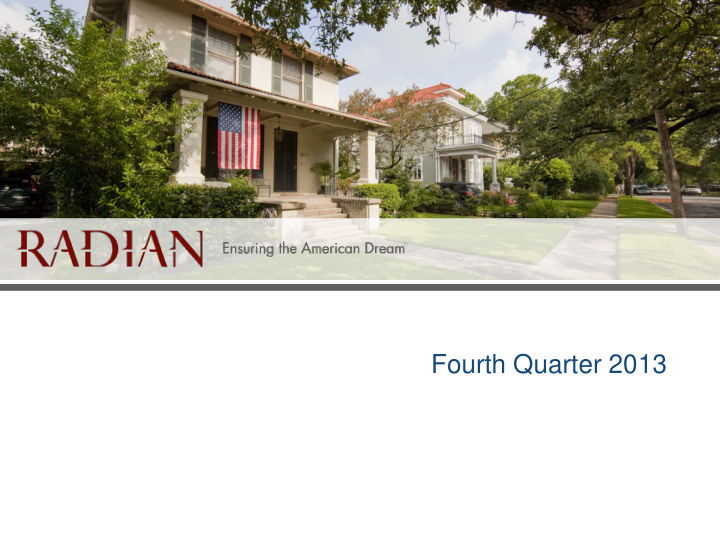



Fourth Quarter 2013
Safe Harbor Statements All statements in this report that address events, developments or results that we expect or anticipate may occur in the future are “forward-looking statements” within the meaning of Section 27A of the Securities Act of 1933, Section 21E of the Securities Exchange Act of 1934 and the United States (“U.S.”) Private Securities Litigation Reform Act of 1995. In most cases, forward-looking statements may be identified by words such as “anticipate,” “may,” “will,” “could,” “should,” “would,” “expect,” “intend,” “plan,” “goal,” “contemplate,” “believe,” “estimate,” “predict,” “project,” “potential,” “continue,” or the negative or other variations on these words and other similar expressions. These statements, which may include, without limitation, projections regarding our future performance and financial condition, are made on the basis of management’s current views and assumptions with respect to future events. Any forward-looking statement is not a guarantee of future performance and actual results could differ materially from those contained in the forward-looking statement. These statements speak only as of the date they were made, and we undertake no obligation to publicly update or revise any forward-looking statements, whether as a result of new information, future events or otherwise. We operate in a changing environment. New risks emerge from time to time and it is not possible for us to predict all risks that may affect us. The forward-looking statements, as well as our prospects as a whole, are subject to risks and uncertainties that could cause actual results to differ materially from those set forth in the forward-looking statements including: changes in general economic and political conditions, including high unemployment rates and weakness in the U.S. housing and mortgage credit markets, a significant • downturn in the U.S. or global economies, a lack of meaningful liquidity in the capital or credit markets, changes or volatility in interest rates or consumer confidence and changes in credit spreads, each of which may be accelerated or intensified by, among other things, legislative activity or inactivity, actual or threatened downgrades of U.S. government credit ratings, or actual or threatened defaults on U.S. government obligations; changes in the way customers, investors, regulators or legislators perceive the strength of private mortgage insurers or financial guaranty providers, in particular in light of the • fact that certain of our former competitors have ceased writing new insurance business and have been placed under supervision or receivership by insurance regulators; catastrophic events, municipal and sovereign bankruptcy filings or other economic changes in geographic regions where our mortgage insurance exposure is more • concentrated or where we have financial guaranty exposure; our ability to maintain sufficient holding company liquidity to meet our short- and long-term liquidity needs; • a reduction in, or prolonged period of depressed levels of, home mortgage originations due to reduced liquidity in the lending market, tighter underwriting standards, and • general reduced housing demand in the U.S., which may be exacerbated by regulations impacting home mortgage originations, including requirements established under the Dodd-Frank Wall Street Reform and Consumer Protection Act (the “Dodd-Frank Act”); our ability to maintain an adequate risk-to-capital position, minimum policyholder position and other surplus requirements for Radian Guaranty Inc. (“Radian Guaranty”), our • principal mortgage insurance subsidiary, and an adequate minimum policyholder position and surplus for our insurance subsidiaries that provide reinsurance to Radian Guaranty; our ability to continue to effectively mitigate our mortgage insurance and financial guaranty losses; • a more rapid than expected decrease in the levels of mortgage insurance rescissions and claim denials which have reduced our paid losses and resulted in a significant • reduction in our loss reserves, including a decrease in net rescissions or denials resulting from: an increase in the number of successful challenges to previously rescinded policies or claim denials (including as part of one or more settlements of disputed rescissions or denials), or by the government-sponsored entities (“GSEs”) intervening in or otherwise limiting our loss mitigation practices, including settlements of disputes regarding loss mitigation activities; the negative impact that our loss mitigation activities may have on our relationships with our customers and potential customers, including the potential loss of current or • future business and the heightened risk of disputes and litigation; the need, in the event that we are unsuccessful in defending our loss mitigation activities, to increase our loss reserves for, and reassume risk on, rescinded or cancelled • loans or denied claims, and to pay additional claims, including amounts previously curtailed; any disruption in the servicing of mortgages covered by our insurance policies, as well as poor servicer performance; • adverse changes in the severity or frequency of losses associated with certain products that we formerly offered (and which remain in our insured portfolio) that are riskier • than traditional mortgage insurance or financial guaranty insurance policies; 2
Recommend
More recommend